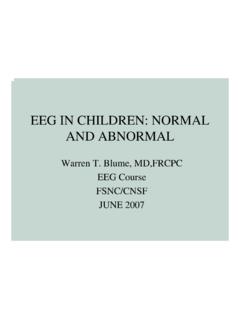Transcription of Abnormal Gas Exchange - Columbia University
1 1 Abnormal Ventilation, Abnormal Gas ExchangeVentilation and Gas Exchange Objective: to achieve adequate tissueoxygenation and remove metabolicallyproduced CO2. Ventilation: concerned with delivery of freshvolume of air to gas exchanging units, andthe removal of a sufficient volume of mixedgas out Gas Exchange : the ability to move gas acrossthe alveolar-capillary membrane2 Ventilation and Gas Exchange The failure of either or both results inimpaired arterial blood gases and ultimatelyrespiratory failure. Ventilatory failure: Hypercapnic respiratoryfailure Gas Exchange failure: Hypoxemic respiratoryfailure Hypoxemia is the inevitable result of bothHypoxemia Low partial pressure of O2 in blood (PaO2) Hypoxemia is not synonymous with:3 Hypoxemia Low partial pressure of O2 in blood (PaO2) Hypoxemia is not synonymous with: Hypoxia (metabolic O2 deficiency)Hypoxemia Low partial pressure of O2 in blood (PaO2) Hypoxemia is not synonymous with: Hypoxia (metabolic O2 deficiency) Low O2 carrying capacity ( ml O2/gm Hgb)4 Hypoxemia Low partial pressure of O2 in blood (PaO2) Hypoxemia is not synonymous with: Hypoxia (metabolic O2 deficiency) Low O2 carrying capacity ( ml O2/gm Hgb) Low O2 content (CaO2:SaO2 x O2 carryingcapacity+.)
2 003 ml O2/100 ml/mmHg PaO2 Hypoxemia Low partial pressure of O2 in blood (PaO2) Hypoxemia is not synonymous with: Hypoxia (metabolic O2 deficiency) Low O2 carrying capacity ( ml O2/gm Hgb) Low O2 content (CaO2:SaO2 x O2 carryingcapacity+.003 ml O2/100 ml/mmHg PaO2 Low O2 delivery (CaO2 x )5 Physiologic Causes ofHypoxemiaAlveolar Hypoventilation Decreased PIO2 Diffusion AbnormalityV/Q mismatchShuntVentilation Minute Ventilation (VE)=tidal volume (VT) xrespiratory frequency Alveolar ventilation (VA)=that part of minuteventilation which participates in gas Exchange Alveolar ventilation=alveolar volume (tidalvolume-dead space volume) x respiratoryfrequency6 Ventilation Alveolar PCO2 (PACO2)=VCO2/VA x K VCO2=CO2 production VA=alveolar ventilation Normal: VCO2/VA=1 ; K=863 mmHg) Alveolar PCO2=CO2 leaving lungs after gasexchange.
3 Directly reflects arterial PCO2 , halving alveolar ventilation with constant CO2production will double the alveolar PCO2 , doubling the alveolar PCO2 reflects halvedalveolar ventilationHypoventilation Inability to inspire and expire a volume ofair/gas sufficient to meet metabolic demands Inabilty to bring a fresh volume of O2 witheach breath to the gas exchanging unit, andinability to remove CO2 produced bymetabolism. Sine qua non: Increased arterial PCO2(PaCO2); decreased arterial PO2 (PaO2)breathing room air (parallel changes!!)7 Hypoventilation/Alveolar hypoventilation All hypoventilation concerns either : increased dead space/tidal volume (anatomicor physiologic), or Decreased MINUTE ventilation (decreasedtidal volume, and/or decreased respiratoryrate) Each is considered alveolar hypoventilation ifPaCO2 is Hypoventilation:2 Clinical Pearls Does not widen the AaDO2 The hypoxemia may be readily amelioratedwith supplemental O28 Alveolar Gas Equation PAO2=PIO2 PACO2/R PAO2=PIO2 PACO2/R + [PCO2 x FIO2 x 1-R/R]Alveolar Gas Equation PAO2=PIO2 PACO2/R PIO2: FIO2 (Patm-PH20)9 Alveolar Gas Equation PAO2=PIO2 PACO2/R PIO2: FIO2 (Patm-PH20) PACO2=PaCO2 Alveolar Gas Equation PAO2=PIO2 PACO2/R PIO2: FIO2 (Patm-PH20) PACO2=PaCO2 R=Respiratory Exchange Ratio.
4 (gas R=CO2added to alveolar gas by blood/amount of O2removed from alveolar gas by blood; lowV/Q=low R); normal= History Room air: PaO2=30 mmHg, PaCO2=90mmHg, pH= PAO2= (760-47) 90 History Room air: PaO2=30 mmHg, PaCO2=90mmHg, pH= PAO2= (760-47) 90 PAO2= History PaO2=30 mmHg, PaCO2=90 mmHg,pH= PAO2= (760-47) 90 PAO2= AaDO2= mmHgAlveolar Hypoventilation CNS: central hypoventilation; infectious,traumatic, vascular damage to medullarycenters; pharmacologic and sleep suppressionof ventilatory drive12 Alveolar Hypoventilation CNS: central hypoventilation; infectious,traumatic, vascular damage to medullarycenters; pharmacologic and sleep suppressionof ventilatory drive Peripheral nervous system/myoneuraljunction: poliomyelitis, Guillain-Barre,myasthenia gravisAlveolar HypoventilationRespiratory muscles: muscular dystrophy, ALS,increased inspiratory loading (eg emphysema)13 Alveolar HypoventilationRespiratory muscles: musculardystrophy,increased inspiratory loading (egemphysema)Chest wall/mechanical restriction:kyphoscoliosis, trauma, splinting, obesityAlveolar HypoventilationRespiratory muscles: musculardystrophy,increased inspiratory loading (egemphysema)Chest wall/mechanical restriction:kyphoscoliosis, trauma, splinting, obesityAirway obstruction: upper airway, lower airway14 Alveolar HypoventilationRespiratory muscles: musculardystrophy,increased inspiratory loading (egemphysema)Chest wall/mechanical restriction.
5 Kyphoscoliosis, trauma, splinting, obesityAirway obstruction: upper airway, lower airwayIncreased dead space ventilation: pulmonaryembolism; COPDH ypercapnic Respiratory Failure Primary deficit=hypoventilation without gasexchange abnormality, until late Hypoxemia MUST result15 Physiologic Causes ofHypoxemiaAlveolar Hypoventilation Decreased PIO2 Diffusion AbnormalityV/Q mismatchShuntClimbing Everest(Decreased PIO2) P atm= 250 mmHg PaCO2=18 mmHg; R=1 PAO2=PIO2-PCO2/R PAO2=.21 (250-47)-18/1= History RA: PaO2=70, PaCO2=30 mmHgCase History RA: PaO2=70, PaCO2=30 mmHg No treatment: RA PaO2=50 mmHg,PaCO2=28 mmHg17 What happened? PAO2=PIO2 PACO2/R FIO2, PaO2=50 mmHg,PaCO2=28 mmHg PAO2= (713)-28 mmHg AaDO2=115-50= 65 mmHgAaDO2 and Hypoxemia Widened in diffusion disorder, V/Qmismatch, and shunt Not widened in alveolar hypoventilation anddecreased PIO2 Normal 10-15 mmHg in young adult18 Hypoxemia No widening of AaDO2: hypoventilation, lowPIO2.
6 Widened AaDO2: shunt, low V/Q, lowdiffusing capacity Hypoxemia of each may be overcome withsupplemental O2 except: shunt. Note: no gas Exchange =no amelioration ofhypoxemia with O2, whether dead space,shunt, or no V/Q Venous admixture Alveolar filling: pneumonia, pulmonaryedema (cardiogenic/non-cardiogenic) COPD a common situation of low V/Q Usually will involve some infinitely low V/Q(shunt) and decreased V/Q Low relationship of V to Q; NOT lowventilation Low V/Q is NOT hypoventilation (unless allunits are the same low V/Q)20 Diffusion Abnormality Alveolar-capillary membrane thickening(pulmonary hypertension, pulmonaryvasculitis, pulmonary embolism) Alveolar-capillary membrane destruction(emphysema) Pulmonary interstitial thickening (pulmonaryfibrosis) Alveolar fillingShunt Infinitely low V/Q Supplemental O2 will not raise PaO2 withlarge shunt Clinical examples: ARDS, other severepneumonia, cardiogenic pulmonary edema May also be cardiogenic R-L shunt2122 Hypoxemic Respiratory Failure Primary deficit=hypoxemia withouthypoventilation, until late Gas Exchange abnormality: shunt, low V/Q,low diffusing capacity, Hypoventilation: High PaCO2, Low PaO2,no widening of AaDO2 Gas Exchange abnormality.
7 Low PaO2,normal to low PaCO2, widened AaDO2 Hypoxemia of all hypoventilation and gasexchange abnormalities may be sufficientlyovercome by supplemental O2 unless gasexchange abnormality is absolute (eg shunt)














